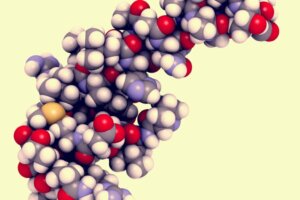The Hormone Hypocretin and its Many Functions

The hormone hypocretin (or orexin) is an excitatory neuropeptide hormone. More specifically, it’s a polypeptide hormone found in the posterior hypothalamus. It has many functions. It makes you feel hungry. Also, it makes you feel alert. Furthermore, and among other things, it makes you feel cheerful. On the other hand, low levels are also linked with sleep disorders such as insomnia or narcolepsy.
You can increase the presence of this hormone by carrying out certain practices related to your diet and lifestyle. For example, you can stimulate its secretion by sunbathing, exercising, eating dairy products, restricting glucose, and increasing fructose.

What’s the hormone hypocretin?
Hypocretin, also known as orexin, is a type of excitatory neuropeptide hormone according to Sakurai et al (1998) and De Lecea et al (1998). These two researchers were the first to discover this hormone in the brains of rats. The name hypocretin originates from the English language and the term was first used in 1998.
Hypocretin is a polypeptide neural hormone. It’s made up of 30 amino acids and it’s found in the hypothalamus. The hypothalamus is the part of the brain that’s involved in physical functions such as appetite, libido, and sleep regulation.
Functions of the hormone hypocretin
Scientists originally believed that hypocretin was involved in food intake stimulation (hunger). They believed this because the central administration of this hormone, more specifically orexin-A/hypocretin-1, was found to increase food intake.
Later, they discovered that hypocretin also stimulated insomnia, energy expenditure, and wakefulness. Indeed, this hormone has several different functions.
State of alertness
Hypocretin, or orexin, promotes alertness. Recent studies suggest that one of its functions is integrating the metabolic influences of circadian rhythms and sleep deprivation. In other words, hypocretin plays an important role in whether an animal should be awake and active or asleep.
Thus, it strongly excites the various nuclei of the brain that have important roles in the occurrence of insomnia (dopamine, acetylcholine, and norepinephrine systems). However, Lin et al (1999) suggest that the orexin/hypocretin receptor can also mutate and cause canine sleep disorders, such as narcolepsy.
Food intake
Hypocretin stimulates and increases your food cravings. When it operates in this way, it also interacts with substances that promote its production. This means it’s able to increase its expression.
However, some animal studies show that low levels of orexin cause obesity. In fact, obesity occurs even when they eat fewer calories.
A possible link to Alzheimer’s disease
Kang et al (2009) linked hypocretin to Alzheimer’s disease. Their study claimed that the expression of the beta-amyloid protein, a peptide that typically appears in Alzheimer’s disease, increases during the day, and decreases at night. Kang et al (2009) further claimed that hypocretin controls this expression of the beta-amyloid protein.
Sleep deprivation causes the development of beta-amyloid plaques. Kang et al (2009) claimed that maintaining appropriate sleep or wakefulness periods prevents Alzheimer’s disease.
Influence on good mood
Hypocretin has a role in emotional and physiological functions. In fact, high levels of hypocretin are linked to a positive mood and happiness.
Anxiety and addictions
It’s believed that low hypocretin levels affect your urges to smoke and drink alcohol. This seems particularly relevant in cases of addiction. In addition, we associate the presence of hypocretin with reward systems. Furthermore, abnormally high levels of hypocretin lead to states of anxiety. Thus, this could mean an addict might relapse.

How to stimulate the hormone hypocretin
You can increase the presence of hypocretin in your body by doing certain things. These include:
- Sunbathing. Hypocretin increases in bright light, such as sunlight.
- Exercise. Exercise acidifies the blood. This increases the excitability of hypocretin.
- Eating foods that contain lactate. Lactate regulates hypocretin and increases your energy.
- Restrict glucose and increase fructose. Elevated glucose levels stop orexin neurons from being active.
Regarding the latter, pasta, wholemeal bread, potatoes, and legumes all contain healthy glucose. In contrast, white bread, savory snacks, and fried foods contain unhealthy glucose.
As you can see, hypocretin is a hormone that works in many ways, both physiologically and psychologically. In fact, due to its link to positive emotions, we call it “the good mood hormone”. Furthermore, it regulates emotions, moods, and sleep/wake cycles. It’s also linked to learning processes.
Finally, experts link altered hypocretin levels to sleep disorders, obesity, and even Alzheimer’s disease.
All cited sources were thoroughly reviewed by our team to ensure their quality, reliability, currency, and validity. The bibliography of this article was considered reliable and of academic or scientific accuracy.
- De Lecea L, Kilduff TS, Peyron C, Gao X, Foye PE, Danielson PE, Fukuhara C, Battenberg EL, Gautvik VT, Bartlett FS, Frankel WN, van den Pol AN, Bloom FE, Gautvik KM, Sutcliffe JG (1998). “The hypocretins: hypothalamus-specific peptides with neuroexcitatory activity”. Proc. Natl. Acad. Sci. U.S.A. 95 (1): 322–7.
- Kang, J.E., Lim, M.M., Bateman, R.J., Lee, J.J., Smyth, L.P., Cirrito, J.R., Fujiki, N., Nishino, S. & Holtzman, D.M. (2009). «Amyloid-{beta} Dynamics Are Regulated by Orexin and the Sleep-Wake Cycle». Science.
- Lin L, Faraco J, et. al. (1999). «The sleep disorder canine narcolepsy is caused by a mutation in the hypocretin (orexin) receptor 2 gene.». Cell 98(3): 365-376.
- Sakurai T, Amemiya A, Ishii M, Matsuzaki I, Chemelli RM, Tanaka H, Williams SC, Richardson JA, Kozlowski GP, Wilson S, Arch JR, Buckingham RE, Haynes AC, Carr SA, Annan RS, McNulty DE, Liu WS, Terrett JA, Elshourbagy NA, Bergsma DJ, Yanagisawa M (1998). “Orexins and orexin receptors: a family of hypothalamic neuropeptides and G protein-coupled receptors that regulate feeding behavior”. Cell 92 (4): 573–85.
This text is provided for informational purposes only and does not replace consultation with a professional. If in doubt, consult your specialist.








